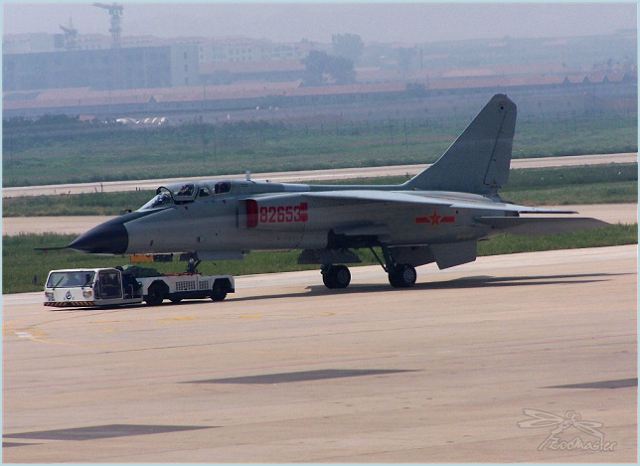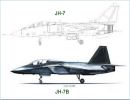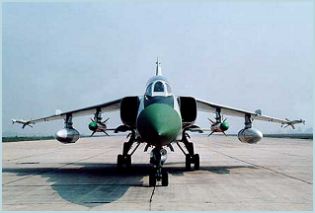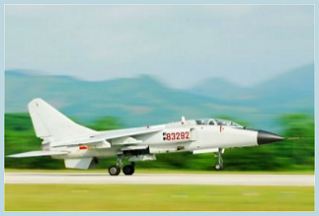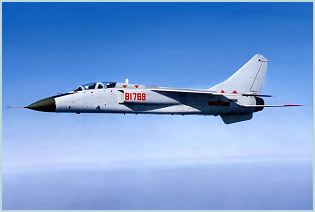JH-7 Xian FBC-1 Flying Leopard Flounder
| |
||||||||||||||||||||||||||
| a | ||||||||||||||||||||||||||
JH-7
Xian FBC-1 Flying Leopard fighter bomber aircraft |
||||||||||||||||||||||||||
|
||||||||||||||||||||||||||
| |
||||||||||||||||||||||||||
The
Xian JH-7 also known as the FBC-1 Flying Leopard (NATO Code Flounder),
is a two-seater (tandem), twin-engine fighter-bomber in service with
the People's Liberation Army Naval Air Force (PLANAF), and the People's
Liberation Army Air Force (PLAAF). This fighter aircraft was designed
and manufactured by Xian Aircraft Industry Corporation. The JH-7 Xian
was first revealed publicly September 1988 as model at Farnborough International
air show, with the first of two prototypes having been rolled out during
previous month. This fighter aircraft is designed to have the same role
and configuration class as the Russian Sukhoi Su-24 'Fencer'. The first
batch of 12 to 18 JH-7 aircraft was delivered to both PLNAF and PLAAF
for evaluation in the 1990's. The upgraded JH-7 is known as JH-7A and
was delivered to PLAAF in 2004. |
||||||||||||||||||||||||||
| Variants | ||||||||||||||||||||||||||
|
||||||||||||||||||||||||||
|
||||||||||||||||||||||||||
|
||||||||||||||||||||||||||
|
||||||||||||||||||||||||||
|
||||||||||||||||||||||||||
| Technical Data | ||||||||||||||||||||||||||
| Design | ||||||||||||||||||||||||||
The
JH-7 has high-mounted wings with compound sweepback and dog tooth leading.
There are two small over-wing fences at approximately two third span
on the basic variant JH-7, but they were removed on the improved JH-7A.
Two pilots sits in tandem in the two-seat cockpit, with the rear seat
slightly higher than the front seat to give the weapon operator a better
filed of view. Each seat has its own back-hinged canopy. The cockpit
and internal fuel tanks are protected by armour plates. |
||||||||||||||||||||||||||
| Avionic | ||||||||||||||||||||||||||
| The
latest version of JH-7 is equipped with navigation and attack system
fiited with a combined inertial and GPS navigation system. The pilot
use a Russian derived helmet mounted sighting (HMS) system that is produced
in China by the Luoyang Electro-Optical Equipment Research Institute
(LOEC). It is a lightweight bracket-mounted system that uses a single
small sighting reticle and a pair of cockpit-mounted IR head tracking
sensors. The system offers a ±60° azimuth and ±40°
pitch off-boresight engagement capability with the PL-9 air-to-air missile.
Helmet weight is 0.2 kg, is utilized off of the 27 volt DC (20 watt)
bus and provides queuing accuracy up to 0°35'. Development work
with the GPS equipped FBC-1 is attempting to have the HMS designate
points on ground thus having them stored directly into the aircraft's
navigation and attack computer as a usable point of reference for future
attack or intelligence retrieval. |
||||||||||||||||||||||||||
| Propulsion | ||||||||||||||||||||||||||
The
JH-7 Xian is powered by two British Rolls-Royce Spey Mk202 turbofan
jet engines, each rated at 54.29kN (5,536kg, 12,250 lbs) dry or 91.26kN
(9,305kg, 20,515 lbs) with afterburning. The fuel-efficient turbofan
engine provides the aircraft with a much extended range (3,650~4,000km)
compared to the turbojet-powered aircraft. The aircraft has no in-flight
refuelling ability. Later production variants are powered by two WS-9
Qingling turbofans, a Chinese licensed copy of the Mk202 built by the
Xi’an Aero Engine Factory (XAE) since 2004. |
||||||||||||||||||||||||||
| Armament | ||||||||||||||||||||||||||
The
JH-7 Xian is armed with a twin-barrel Type 23-III 23mm cannon with 200
rounds in a ventral installation, which can fire 300 rounds per gun.
Up to 5,000kg weapon loads and/or drop tanks can be carried on external
hardpoints (seven on JH-7 and eleven on JH-7A). While the early variant
JH-7 could only carry anti-ship missiles and free-fall bombs, the improved
JH-7A is capable of delivering a full range of precision guided and
stand-off weapons. The JH-7 Xian is fitted with two store pylons under each wing. The wingtip rails of JH-7 can carried air-to-air missiles PL-5, C-801 or C-802 (YJ-1) sea-skimming anti-ship missile. |
||||||||||||||||||||||||||
| Specifications | ||||||||||||||||||||||||||
|
||||||||||||||||||||||||||
|
||||||||||||||||||||||||||
|
||||||||||||||||||||||||||



























